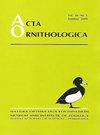野生黑客放生的人工繁殖萨克猎鹰的运动和生存:对放生管理的启示
IF 1.3
4区 生物学
Q3 ORNITHOLOGY
引用次数: 10
摘要
摘要了解迁移个体的行为和生存对于成功地管理旨在将物种恢复到其以前分布范围的保护方案至关重要。我们研究了10只配有卫星接收发射机的人工饲养的Saker Falcons Falco cherrug的活动和生存情况,这些猎鹰于2012年至2014年在保加利亚被野生黑客释放。雏鸡由父母饲养,在25-35天大时,以3-4只雏鸟为一组,转移到hack笼中,在那里他们没有直接接触人类。雏鸟在43-51日龄时离开背带笼,在背带笼内提供食物,将雏鸟留在附近。卫星追踪的鸟类在hack cage附近平均停留28天(范围5-49天),扩散后的生存与在hack cage附近停留的时间长度呈正相关。我们发现,在追踪期间,作为生存的代理,易地和野生羽翼的Saker猎鹰在欧洲没有显著差异。已知有五种鸟停止传播的原因;其中三只被输电线触电身亡,一只被困在大楼里身亡,还有一只在北非被捕鹰人捉住。圈养繁殖的鸟类表现出与其野生同类相似的运动和定居行为:以不同的方向分散,建立分散后的临时定居区,并迁移到离散的越冬范围。至少存活到第二年的鸟类表现出一定程度的出生哲学,在距离栖息地45-160公里的地方建立夏季活动范围。2015年和2016年,在孵卵周围的喂养站进行补给,使孵卵区滞留时间平均提高到38天和43天,初生后40天的表观存活率分别为97.7天和98.9%。2018年和2019年在保加利亚繁殖的一对Saker猎鹰来自2015年被黑客入侵的试验群,这表明圈养繁殖的鸟类的易位可能会被用来将该物种恢复到其以前的繁殖分布范围。本文章由计算机程序翻译,如有差异,请以英文原文为准。
Movement and Survival of Captive-Bred Saker Falcons Falco cherrug Released by Wild Hacking: Implications for Reintroduction Management
Abstract. Knowledge of the behaviour and survival of translocated individuals is vital for successful management of conservation programmes aimed at restoring species to their former distribution range. We examined movements and survival of 10 captive-bred Saker Falcons Falco cherrug fitted with satellite-received transmitters, which were released by wild-hacking in Bulgaria in 2012–2014. Chicks were parent-reared in captivity and transferred to hack cages when 25–35 days old in groups of 3–4 nestlings, where they were fed without direct human contact. After leaving the hack cages at 43–51 days old, fledglings were retained in the vicinity by food provisioning at the hack cage. Birds tracked by satellite remained in the vicinity of the hack cage for an average of 28 days (range 5–49 days) and post-dispersal survival was positively associated with the length of time spent in the hack vicinity. We found no significant difference in tracking period, as a proxy of survival, for translocated and wild-fledged Saker Falcons in Europe. The cause of transmission cessation was known for five birds; three were electrocuted by power distribution lines, one died after becoming trapped in a building and another was caught by falcon trappers in North Africa. Captive-bred birds exhibited similar movement and settlement behaviour as their wild congeners: dispersing at varied headings, establishing post-dispersal temporary settlement areas and migrating to discrete wintering ranges. Birds surviving to at least their second year showed some degree of natal philopatry, establishing summer ranges 45–160 km from their hack sites. Provisioning at feeding stations around the hack in 2015 and 2016 improved retention in the hack area to an average of 38 and 43 days, and apparent survival during the first 40-days after fledging was 97.7 and 98.9% respectively. A pair of Saker Falcons that bred in Bulgaria in 2018 and 2019 was from a trial cohort hacked in 2015, indicating that translocation of captive-bred birds can potentially be used to restore the species to this part of its former breeding distribution range.
求助全文
通过发布文献求助,成功后即可免费获取论文全文。
去求助
来源期刊

Acta Ornithologica
生物-鸟类学
CiteScore
2.10
自引率
0.00%
发文量
14
审稿时长
>12 weeks
期刊介绍:
Publishes scientific papers (original research reports, reviews, short notes, etc.) and announcements from all fields of ornithology. All manuscripts are peer-reviewed.
Established in 1933 as Acta Ornithologica Musei Zoologici Polonici, since 1953 continued under the present title.
Published twice a year by the Natura Optima Dux Foundation under the auspices of the Museum and Institute of Zoology, Polish Academy of Sciences.
 求助内容:
求助内容: 应助结果提醒方式:
应助结果提醒方式:


